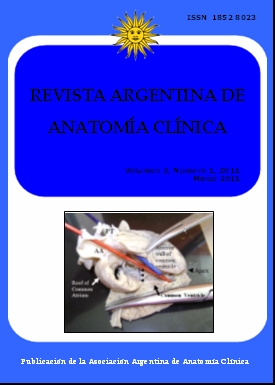AN UNUSUAL CASE OF CONGENITAL ANOMALY OF THE HEART. Un caso poco común de anomalía congénita del corazón
DOI:
https://doi.org/10.31051/1852.8023.v3.n1.13916Keywords:
inter-atrial septum, inter-ventricular septum, ventricle, atrium, atrio-ventricular canal, tabique interauricular, tabique interventricular, ventrículo, aurícula, canal aurículo-ventricularAbstract
La creciente utilización de diagnósticos invasivos y procedimientos de intervención en enfermedades cardiovasculares han enfatizado la importancia de entender y documentar mejor el tipo y la frecuencia de las variaciones vasculares. Los defectos del corazón se encuentran entre las anomalías congénitas más comunes. Estas pueden ser simples o complejas. En la mayoría de las anomalías congénitas del corazón se requiere intervención quirúrgica para garantizar la vida. Los médicos y cirujanos deben ser educados sobre las distintas formas de enfermedades congénitas del corazón para facilitarles su manejo. En este artículo reportamos un caso de un recién nacido de 28 días de raza india al cual se le detectó, durante la autopsia, una anomalía muy poco frecuente. Esta consistía en la presencia de una sola aurícula y un sólo ventrículo comunicados por un sólo orificio aurículo-ventricular. Casos como este son incom-patibles con la vida.
The increasing use of invasive diagnostic and interventional procedures in cardiovascular diseases makes it important that the type and frequency of vascular variations are well documented and understood. Congenital heart defects are among the most common of all birth defects. They can be thought of being common or complex lesions. In most cases of complex congenital heart defects surgical intervention is required in order to sustain life. Surgeons and Physicians need to be informed of the various forms of congenital heart diseases in order to be able to manage such conditions. We report an unusual case found on autopsy of a 28 days old male East Indian neonate, who had single atrial and single ventricular chambers of the heart, which were connected by common atrio-ventricular orifice. This congenital heart defect has to be documented. Such cases are usually incompatible with life.
References
Allan, LD. 1999. Atrio-ventricular septal defects in the fetus. Am J Obstet Gynecol. 181: 1250-1253.
Barry, R.; Keeton; Fergus, J; Macartney; Hunter, S; Mortera, C; Rees, P; Shinebourne, AE; Tynan, M; Wilkinson, JL; Anderson, RH. 1979. Univentricular heart of right ventricular type with double or common inlet. Circulation. 59: 403-411.
Hameed, AB; Goodwin, TM; Elkayam, U. 2007. Effect of pulmonary stenosis on pregnancy outcomes--a case-control study. Am Heart J. 154: 852-854.
Lev, M; Arcilla, R; Rimoldi, HJ; Licata, RH; Gasul, BM. 1963. Premature narrowing or closure of the foramen ovale. Am Heart J. 65: 638-647.
Nora, JJ. 1968. Multifactorial inheritance hypothesis for etiology of congenital heart diseases: The Genetic-Environmental Interaction. Circulation. 38: 604-617.
Ramegowda, S; Ramchandra, NB. 2005. An understanding the genetic basis of congenital heart disease. Indian Journal of human genetics, January-April: 14-23.
Rao, PS; Striepe, V; Merrill, WH. 1994. Hypoplastic left heart syndrome. In: Kambam J (ed.). Cardiac Anesthesia for Infants and Children. St. Louis, MO: Mosby-Year Book. 296-309.
VanPraagh, R; Litovsky S. 1999. Pathology and embryology of common atrio-ventricular canal. Prog Pediatr Cardiol 10: 115-27.
Downloads
Published
Issue
Section
License
Authors retain copyright and grant the journal right of first publication with the work simultaneously licensed under a Creative Commons Attribution License that allows others to share the work with an acknowledgement of the work's authorship and initial publication in this journal. Use restricted to non commercial purposes.
Once the manuscript has been accepted for publications, authors will sign a Copyright Transfer Agreement to let the “Asociación Argentina de Anatomía Clínica” (Argentine Association of Clinical Anatomy) to edit, publish and disseminate the contribution.



